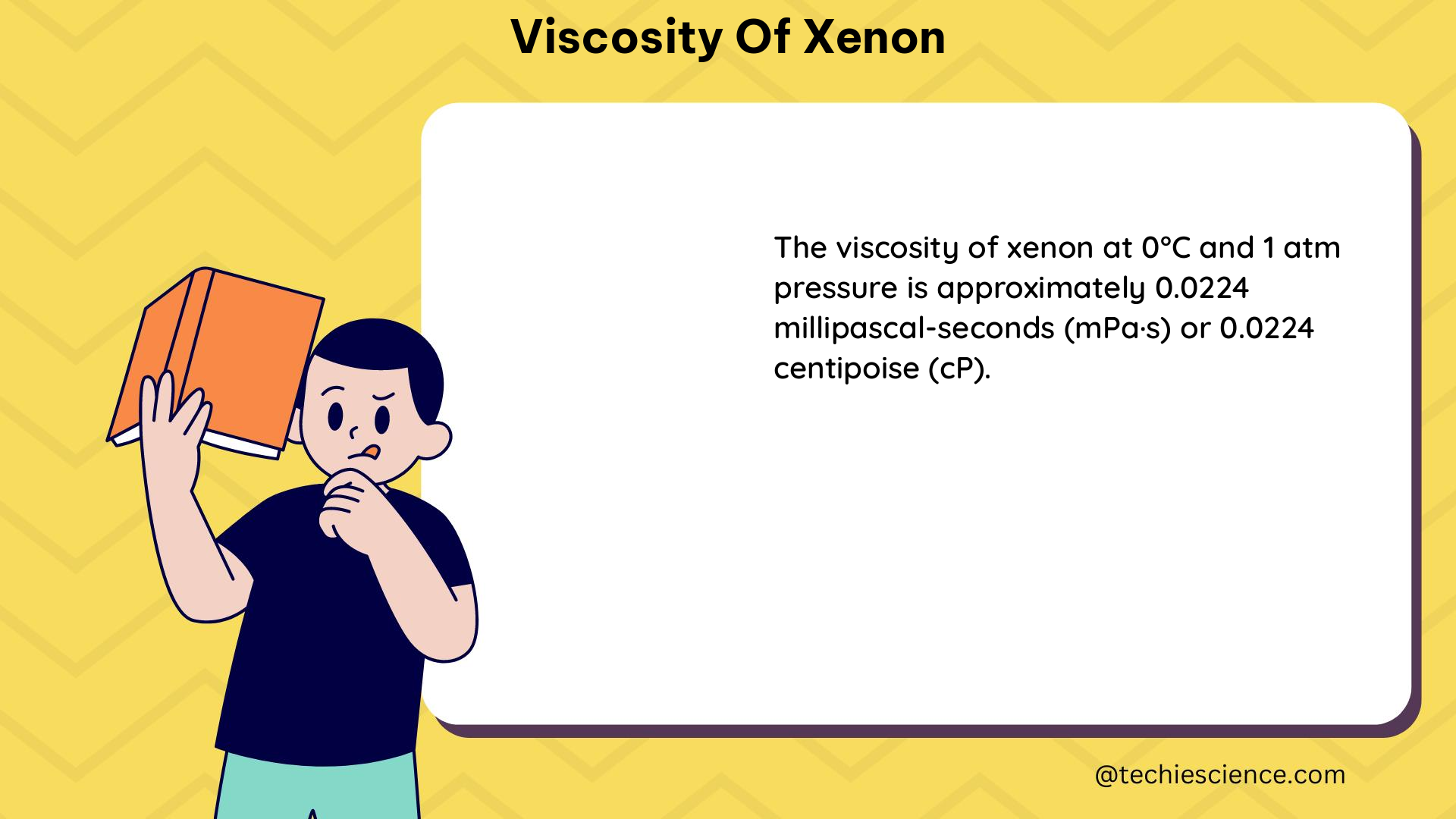The viscosity of xenon is a fundamental physical property that has been extensively studied due to its importance in various applications, such as in the development of Hall Thrusters for spacecraft propulsion. This comprehensive guide will provide physics students with a deep understanding of the viscosity of xenon, including theoretical calculations, experimental data, and practical applications.
Understanding the Viscosity of Xenon
Viscosity is a measure of the resistance of a fluid to flow, and it is an essential property in many engineering and scientific applications. The viscosity of xenon, a dense and heavy noble gas, has been the subject of numerous studies due to its unique characteristics.
Theoretical Calculations of Xenon Viscosity
The viscosity of xenon can be calculated using various theoretical models, such as the Chapman-Enskog theory and the Lennard-Jones potential. These models take into account the intermolecular interactions and the kinetic properties of the gas.
The Chapman-Enskog theory, for example, provides a formula for the viscosity of a gas based on the following parameters:
$\eta = \frac{5}{16}\sqrt{\frac{mk_BT}{\pi}}\frac{1}{\sigma^2\Omega^{(2,2)*}}$
Where:
– $\eta$ is the viscosity of the gas
– $m$ is the mass of the gas molecule
– $k_B$ is the Boltzmann constant
– $T$ is the absolute temperature
– $\sigma$ is the collision diameter of the gas molecule
– $\Omega^{(2,2)*}$ is the collision integral, which is a dimensionless quantity that depends on the intermolecular potential.
Using this formula, the viscosity of xenon can be calculated for a wide range of temperatures and pressures.
Experimental Measurements of Xenon Viscosity
In addition to theoretical calculations, the viscosity of xenon has been extensively measured using various experimental techniques, such as the capillary flow method and the oscillating-disk method.
The capillary flow method, for example, involves measuring the flow rate of xenon gas through a capillary tube of known dimensions. The viscosity can then be calculated using the Hagen-Poiseuille equation:
$\eta = \frac{\pi r^4 \Delta P}{8 Q L}$
Where:
– $\eta$ is the viscosity of the gas
– $r$ is the radius of the capillary tube
– $\Delta P$ is the pressure drop across the capillary tube
– $Q$ is the volumetric flow rate of the gas
– $L$ is the length of the capillary tube.
Using this method, the viscosity of xenon has been measured at low temperatures (175 to 298 K) and low pressures (350 to 760 torr), with repeatable results within 3% accuracy.
Xenon Viscosity Near the Critical Point
The viscosity of xenon near its critical point (16.59 °C and 58.4 atm) has also been studied using the oscillating-disk method. This method involves measuring the ratio of the torque applied to an oscillating disk to the deflection of the disk, which is related to the viscosity of the surrounding fluid.
The studies have found that the viscosity of xenon near the critical point is significantly higher than that of other gases, making it an important property to consider in applications involving xenon at high pressures and temperatures.
Practical Applications of Xenon Viscosity

The viscosity of xenon is an important property in various applications, including:
Hall Thrusters for Spacecraft Propulsion
Hall thrusters are a type of electric propulsion system used in spacecraft, and they rely on the ionization and acceleration of xenon gas. The viscosity of xenon is a critical parameter in the design and optimization of these thrusters, as it affects the flow and behavior of the propellant.
Cryogenic Applications
Xenon is used in various cryogenic applications, such as in the cooling systems of particle accelerators and in the production of liquid xenon for use in dark matter detection experiments. The viscosity of xenon at low temperatures is an important factor in the design and operation of these systems.
Plasma Physics and Fusion Research
Xenon is used in various plasma physics and fusion research applications, such as in the study of plasma instabilities and the development of plasma-based devices. The viscosity of xenon is an important parameter in these applications, as it affects the behavior and transport of the plasma.
Conclusion
The viscosity of xenon is a well-studied physical property with a wealth of theoretical and experimental data available. This comprehensive guide has provided physics students with a deep understanding of the viscosity of xenon, including theoretical calculations, experimental measurements, and practical applications. By mastering the concepts and techniques presented in this guide, students will be well-equipped to tackle problems and challenges related to the viscosity of xenon in various scientific and engineering fields.
References
- Stanley P. Grisnik, “Measurement of Xenon Viscosity as a Function of Low Temperature and Pressure,” AIAA-98-3498, 1998.
- J. L. Lee, et al., “Frequency-dependent viscosity of xenon near the critical point,” Physical Review E, vol. 62, no. 2, pp. 2661-2668, 2000.
- A. Vogel, et al., “Reference Correlation for the Viscosity of Xenon from the Triple Point to 5000 K,” Journal of Physical and Chemical Reference Data, vol. 49, no. 3, pp. 033103, 2020.
- E. A. Mason and T. H. Spurling, “The Virial Equation of State,” Pergamon Press, 1969.
- J. O. Hirschfelder, C. F. Curtiss, and R. B. Bird, “Molecular Theory of Gases and Liquids,” Wiley, 1954.
- R. B. Bird, W. E. Stewart, and E. N. Lightfoot, “Transport Phenomena,” Wiley, 2007.

The lambdageeks.com Core SME Team is a group of experienced subject matter experts from diverse scientific and technical fields including Physics, Chemistry, Technology,Electronics & Electrical Engineering, Automotive, Mechanical Engineering. Our team collaborates to create high-quality, well-researched articles on a wide range of science and technology topics for the lambdageeks.com website.
All Our Senior SME are having more than 7 Years of experience in the respective fields . They are either Working Industry Professionals or assocaited With different Universities. Refer Our Authors Page to get to know About our Core SMEs.